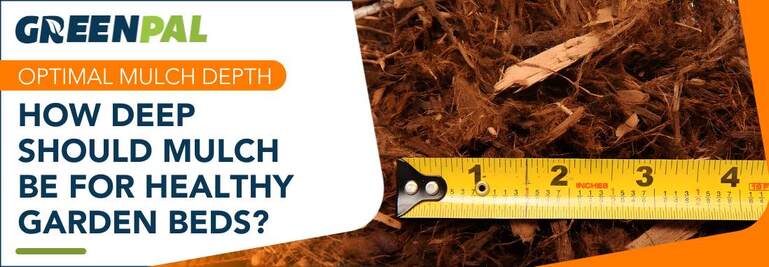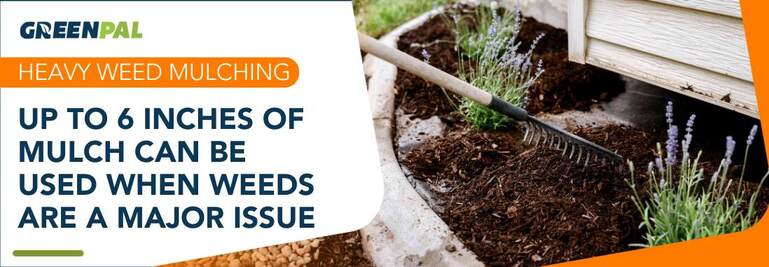How thick should I mulch my beds? (Mulch Depth 101)

If you are looking at your lawn and thinking that your landscape could use a freshing up…
Well then... mulching will give it a nice clean look.
Mulching is a dual-purpose solution that beautifies your garden while promoting plant health
During my 15 years running a landscaping company in Nashville, TN, most of our clients would re-mulch once a year.
Some would ask for it twice a year (when budget was not a factor) in the spring and fall.
In my experience mulching is 50% aesthetic, and 50% necessary for the health of your plants.
But how thick should you apply mulch?
If you want to know, stay tuned!
How thick should I mulch my garden beds?
So if you've decided that it's time to mulch, the next question is how thick should you go?
Well, that depends on how often you are dressing the beds with mulch. And you want to know how thick you are going to apply mulch before you purchase it. That way you can calculate the amount of mulch you will need accurately.
Annual Mulch Application Generally (2-3 Inches)

If you are mulching at least once a year then 2-3 inches is typically enough. In general, you can simply apply enough to where you can't see any of the old mulch, but no more than that.
Unless weeds are a major problem. Simply applying enough to cover the old mulch is typically enough for maintenance mulching.
New Beds or Mulching Every Few Years (4-5 Inches)
If it has been a couple of years since you have re-mulched. Or your garden bed has never been mulched. then you will need to go thicker, say 4-5". All of the mulch in your beds will biodegrade to bare soil in 3-4 years, if not sooner.
So the longer you wait between redressing the beds, the more mulch you will have to replace.
And if your garden bed is brand new, you will also want to be sure you apply 4-5 inches of mulch.
Do Not Pile Mulch At the Base of Plants
Remember, never pile mulch on the trunk of a tree or branch. Piling too much mulch at the base of a tree, shrub, or other plant can lead to rot, and kill your plants. Be careful to avoid piling mulch against the base of your plants
If Weeds Are A Problem (Up to 6 Inches)

Look, if there is a huge issue with weeds in your area. You can pile up to 6 inches of mulch, but you should avoid putting any more than that.
While we do not recommend landscape fabric for garden beds. If you feel that more than 6 inches of mulch is needed to fight the weeds in your area. It may be better to use landscape fabric.
You may also want to consider a pre-emergent treatment to help keep weeds from sprouting in your mulch. Cornmeal is an excellent pre-emergent and its 100% natural!
Too Much Mulch Could Cause a Fire
This is crazy but, applying more than 6 inches of mulch could lead to a fire. Much like wet straw, mulch can catch fire when too much heat is expelled through the process of decomposition, and flammable gases form.
This is why It is also a good idea to keep mulch 18 inches from your home, and never throw your cigarette butts in mulch.
One last tip! A pitchfork is great for applying the mulch and moving it around but be careful not to overdo it.
Mulching Dos and Don'ts
Do's |
Don'ts |
|---|---|
Use a pitchfork for even application |
Pile mulch against the base of plants |
Keep mulch 18 inches from home |
Apply more than 6 inches (unless combating weeds) |
Consider cornmeal as a pre-emergent |
Use in areas prone to mulch-related fires |
Why Regular Mulching is Important
Look, there is nothing that sharpens up the look of a lawn like a fresh application of mulch. Mulching at least once a year will keep your garden beds looking their best. Better yet, mulch is relatively cheap.
But looks aren't all mulch is good for. Regular mulching is also beneficial for the plants in your garden.
Mulch can:
Retain moisture in the ground,
Prevents nematode insect infestations that may target your plants,
Keeps the ground cooler in warm weather,
And keeps the ground warmer in cold weather.
Mulching annually in the south can keep your plants cool and hydrated all summer long.
In the north, you may want to consider a second mulch application annually in the fall. This will keep your plants warmer in the winter months. And this can help protect plants like roses from dying in the winter frost.
TL;DR
Scenario |
Recommended Mulch Depth |
Notes |
|---|---|---|
Annual Mulching |
2-3 inches |
Ideal for general maintenance. |
Bi-Annual Mulching |
2-3 inches |
Recommended for better aesthetic or extreme conditions. |
New Garden Beds |
4-5 inches |
Necessary for adequate plant protection. |
Infrequent Mulching |
4-5 inches |
Compensates for decomposition over time. |
Moderate Weeds |
3-4 inches |
Sufficient for weed suppression. |
Severe Weeds |
Up to 6 inches |
Use landscape fabric for depths beyond 6 inches. |
The Right Mulch Depth At the End of the Day
Look, if you apply mulch every year, 2-3 inches is sufficient. And unless you are fighting very aggressive weeds, there really isn't a good reason to go any thicker.
Plus, if you go thicker than necessary you are just wasting money on mulch, and creating unnecessary work.
I hope this info helps you gauge how much mulch to apply on your re-mulching project. And if you need a lawn care pro to help you out with your mulching project, reach out to the pros at GreenPal for free quotes.





 Share
Share












